Teaching your dog new tricks is a fundamental aspect of responsible pet parenting. Beyond simple entertainment, these engaging activities play a crucial role in helping your new dog develop vital impulse control and provide essential mental and physical stimulation. For new dog owners and seasoned trainers alike, understanding the Easiest Tricks To Teach Your Dog can lay a strong foundation for a well-behaved and happy companion.
Effective dog training helps your canine companion develop valuable skills, improve overall behavior, and boost their understanding of the world around them. When a dog comprehends a command and can execute it consistently, they tend to behave much better in various situations, whether interacting with other dogs, people, or navigating new environments. This foundational training, including mastering tricks like sit or stay, can also pave the way for more complex lessons, such as specific tricks to teach a belgian malinois. Consistent practice of these basic commands strengthens the bond between you and your pet and contributes to a harmonious household.
1. Sit
Sit is universally recognized as one of the most fundamental and easiest tricks to teach your dog. It serves as the cornerstone for nearly all subsequent dog tricks and obedience commands. Once your pet has thoroughly perfected the sit command, they will find it significantly easier to grasp other more advanced maneuvers. Building on this basic foundation, you can even teach entertaining variations like sit pretty to amuse friends and family, making it a truly versatile skill.
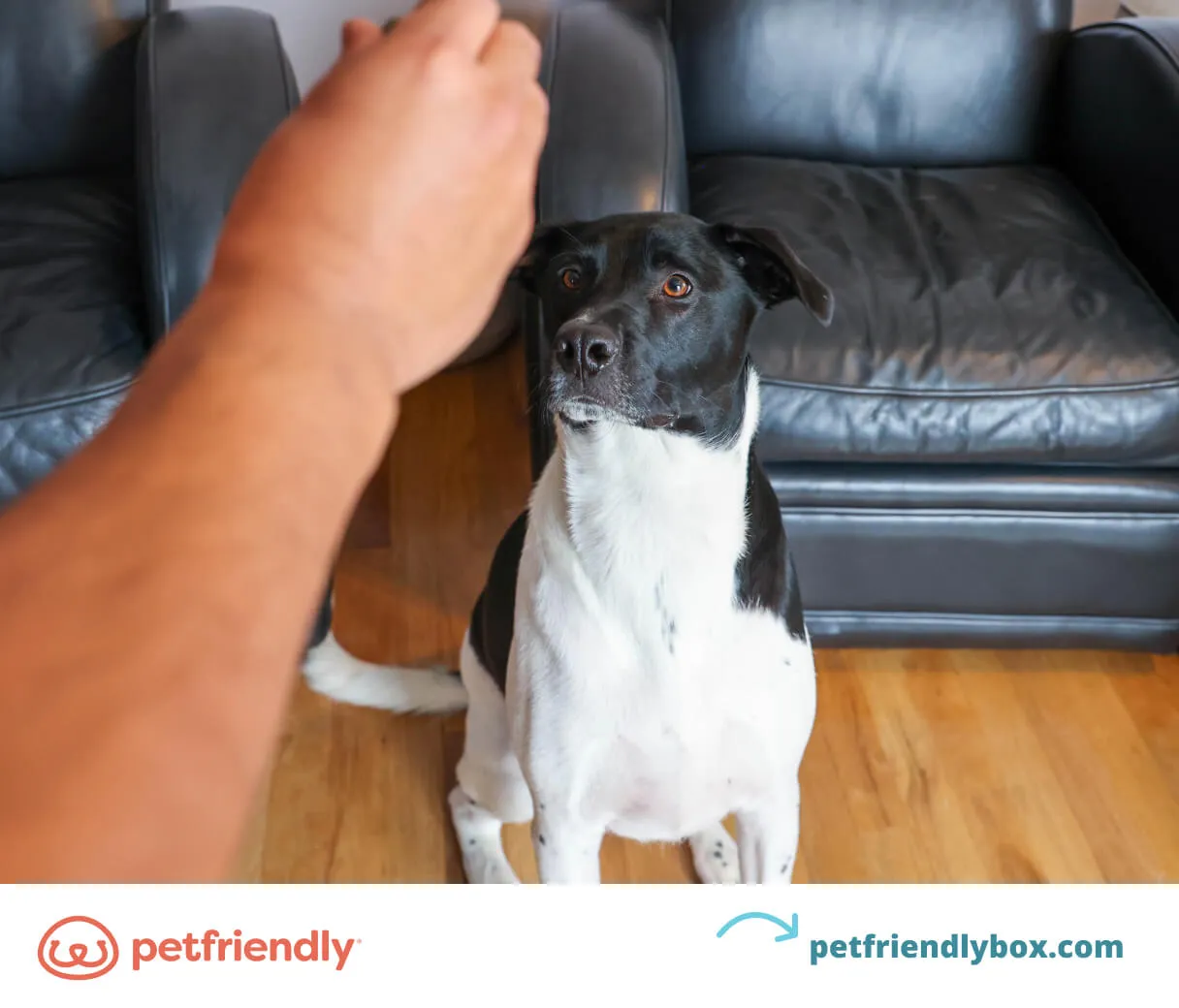 Golden retriever sits patiently, demonstrating the basic 'sit' command
Golden retriever sits patiently, demonstrating the basic 'sit' command
How to teach your dog to sit
Lure with a high-value treat. Begin by holding a desirable dog treat close to your dog’s nose while they are standing. Slowly lift the treat upwards and slightly backward over their head, guiding it towards their rear end. As your dog’s nose follows the treat, their hindquarters will naturally lower into a sitting position.
Add the command. The moment your dog sits, clearly say the command “sit,” immediately reward them with the treat, and offer enthusiastic verbal praise such as “yes” or “good.” Consistently repeat this process, pairing the action with the verbal command, until your pet reliably sits upon hearing the cue alone.
2. Stay
Teaching your dog to stay is another crucial and easiest trick to teach your dog, forming an essential part of basic obedience. This command is incredibly practical for everyday scenarios, whether you need to keep your dog close by in a busy area or prevent them from approaching other people or animals inappropriately.
The stay command is particularly effective in helping young pups develop essential impulse control. As your dog matures and grows older, this early training in stay will remain a vital skill, contributing to their calm and controlled behavior in various situations throughout their life.
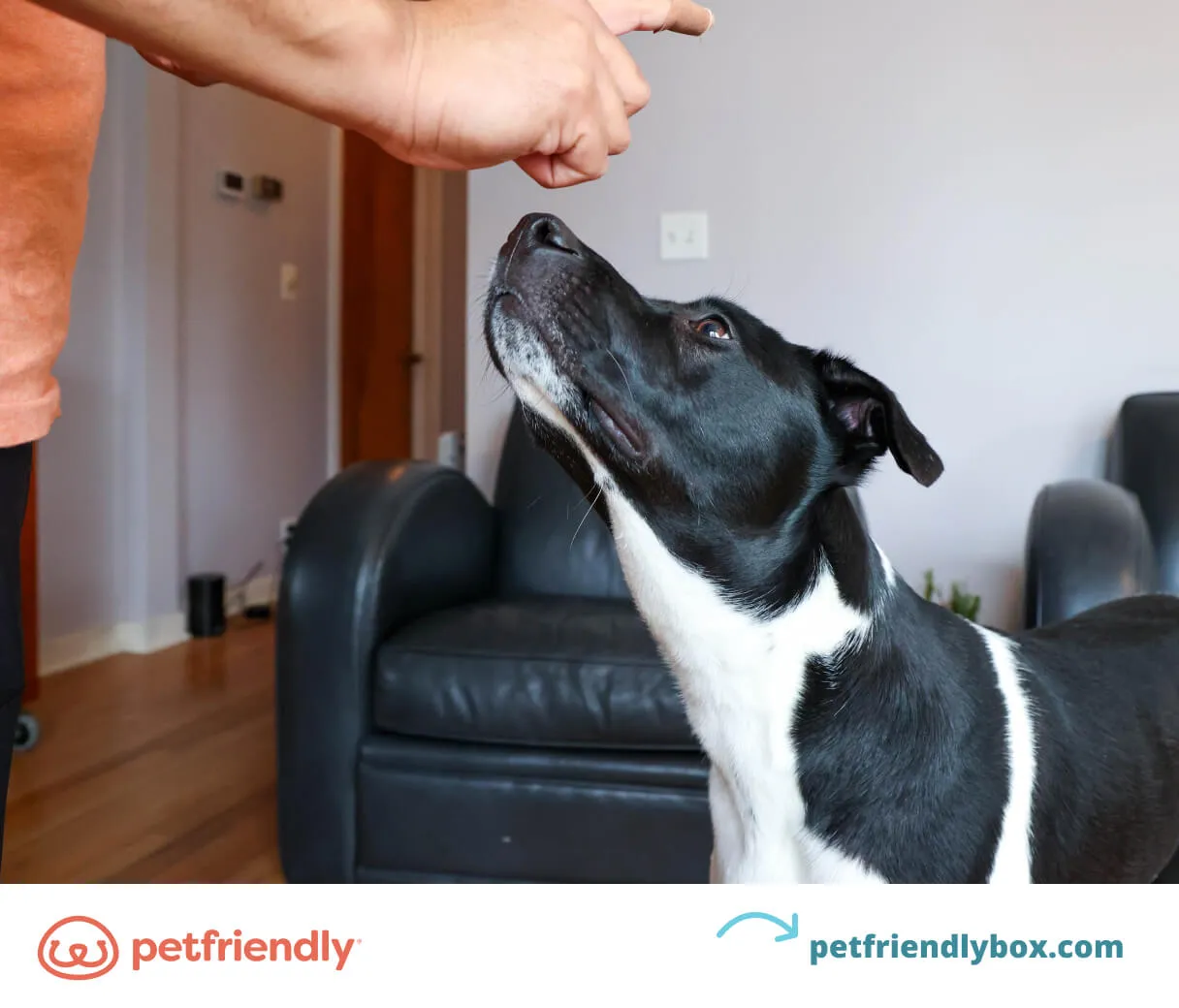 Confident dog holding a 'stay' command, illustrating impulse control training
Confident dog holding a 'stay' command, illustrating impulse control training
How to teach your dog to stay
Start with “sit.” Initiate the stay training by first instructing your dog to sit. Once your dog is comfortably in a sitting position, immediately reward them with a treat and praise.
Add the command. While your dog is seated, clearly give the verbal cue “stay.” Take a step back or wait a few seconds. If your dog remains seated and has not moved, say their release word (which you’ll introduce next) and then reward them with a treat and praise.
Increase the duration. Gradually extend the time your dog must stay before receiving the reward. Repeat this process, adding longer pauses between the command and the release. Once your dog reliably associates staying put with the command, try taking a few steps away from them while maintaining eye contact, then return to reward.
Release and repeat. As your dog masters holding the stay command, systematically increase the duration, introduce mild distractions, or even try momentarily leaving the room for a greater challenge. Always remember to use their release word before rewarding.
Release words
Experienced dog trainers commonly utilize release words to signal to dogs that a command has ended. Introduce a distinct release word to clearly communicate to your dog when they are finished with the trick and free to move. Common release words for dog tricks include:
- O.K.
- Release
- Go
- Break
- Free
Your chosen release word can be anything you prefer, as long as you use it consistently. Be sure to practice the full stay command, culminating in the release word and reward, until your dog confidently remains in position until you give them permission to break.
3. Come
Teaching your dog to come when called is a profoundly important and easiest trick to teach your dog for both safety and peace of mind. Few things are as stressful as your pup running off and refusing to return to you, especially in potentially dangerous situations.
The come or here command is invaluable for keeping your dog safe. If a dangerous animal, another dog, or a vehicle is approaching your pet, you can use the come command to swiftly get them away from potential harm. Moreover, once your dog masters this fundamental dog trick, you’ll experience less stress during off-leash adventures. They will be able to confidently explore, sniff around, and reliably return to you when called.
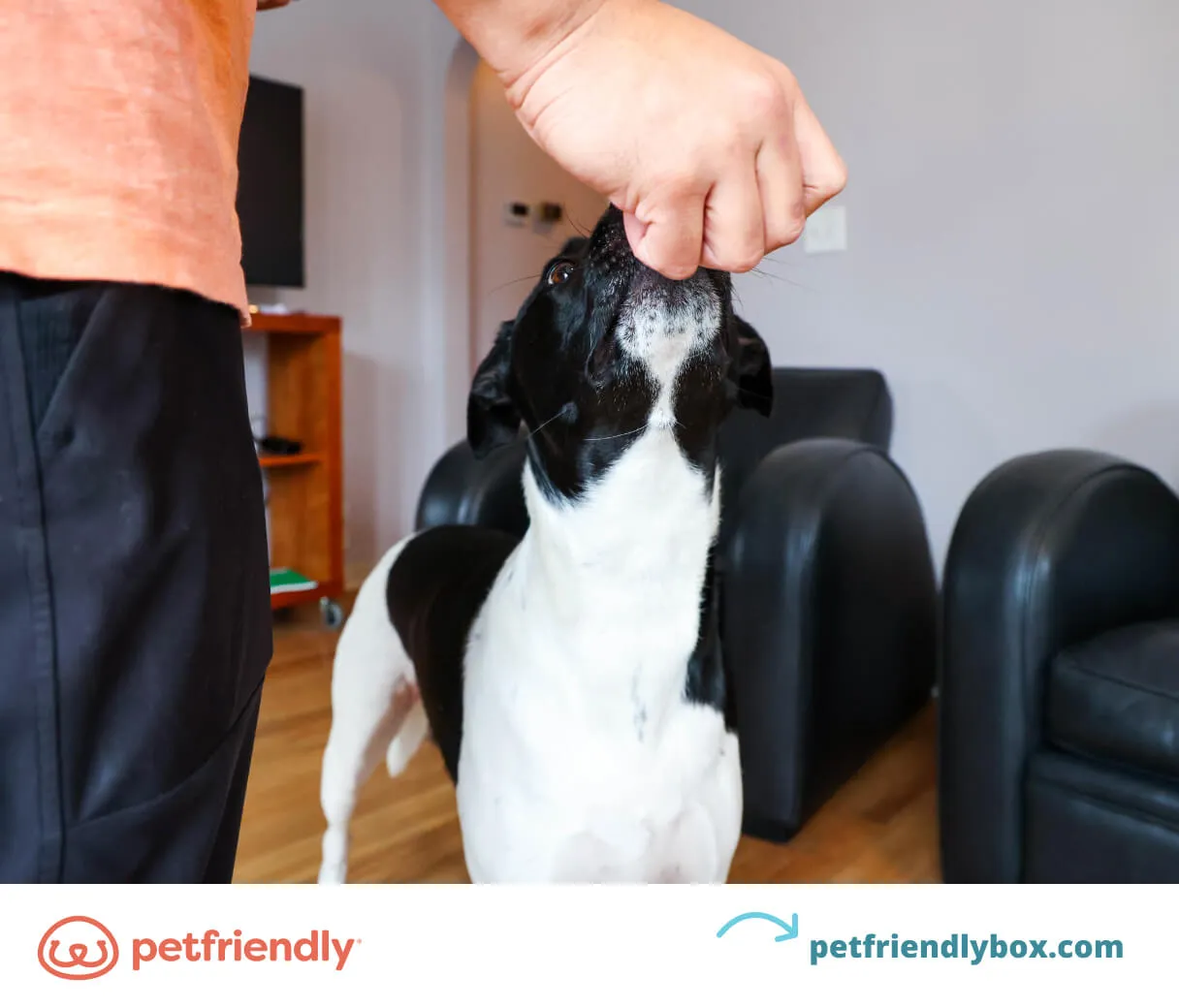 Happy dog eagerly coming when called by its owner during training
Happy dog eagerly coming when called by its owner during training
How to teach your dog to come when called
Give them some space. To initiate come training, start by positioning yourself a few yards away from your pet in a safe, enclosed area.
Add the command. Clearly say your dog’s name, followed by the command “come” or “here.” As your pet begins to move towards you, provide enthusiastic positive reinforcement through cheering or by saying “good dog!”
Reward, reset, repeat. The moment your dog reaches you, reward them with a high-value treat. Offer additional pets, pats, and rubs to let them know they’ve done an excellent job. Then, say your pet’s release word to end the command and wait a few moments before beginning the practice again.
4. Leave it
The leave it command is designed to teach your dog to automatically disengage from and ignore items on the ground that are not meant for them. Training your dog to leave it is a critical safety skill that can potentially save their life.
For instance, if you accidentally drop a piece of human food that could be toxic to your dog, or worse, medication, telling them to “leave it” will prevent your dog from quickly ingesting it before you can intervene. Once your dog has learned to leave it, they should instinctively look to you for approval before attempting to eat anything they find on the ground.
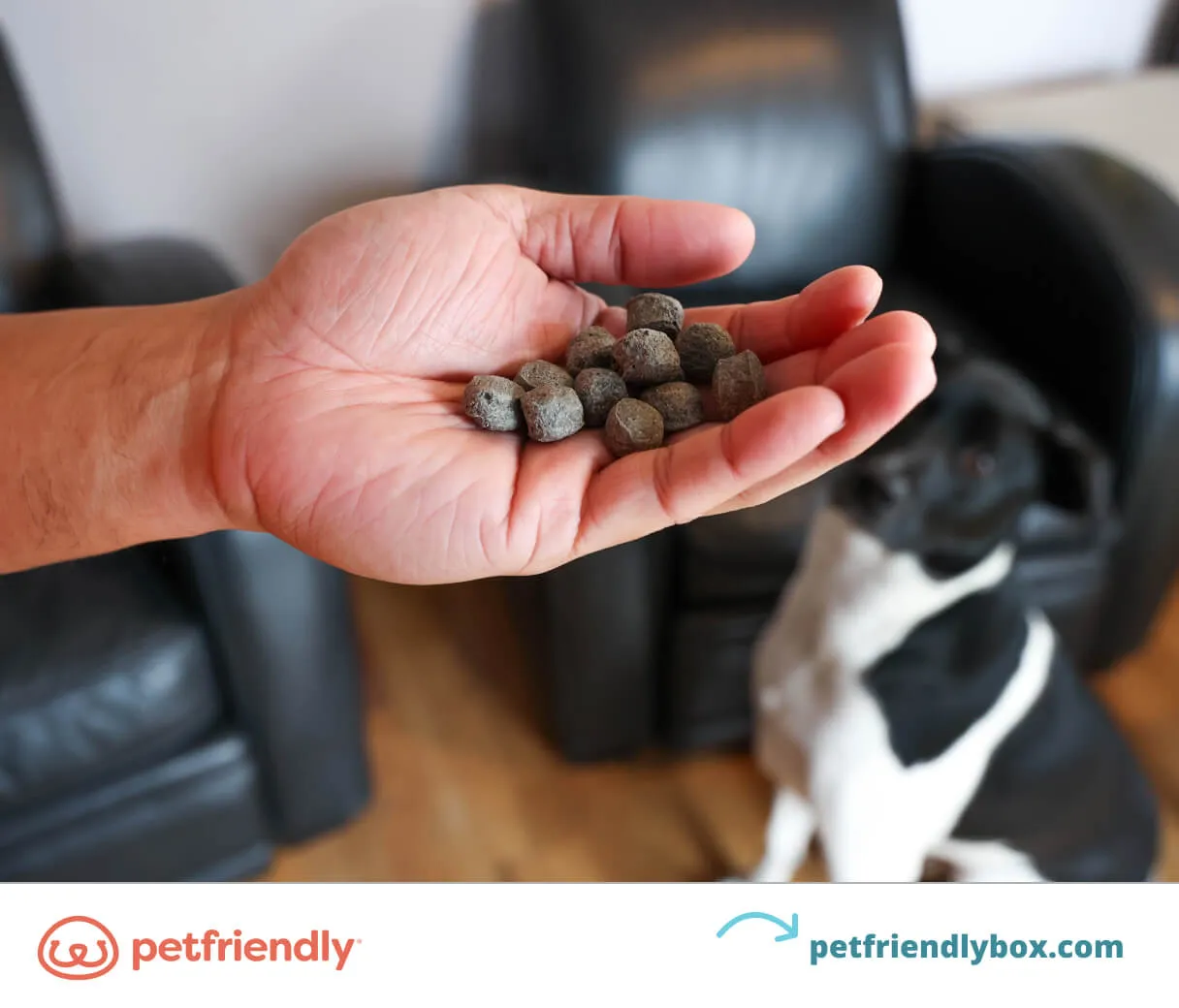 Dog attentively ignoring a treat on the floor, practicing the 'leave it' command
Dog attentively ignoring a treat on the floor, practicing the 'leave it' command
How to teach your dog to leave it
Lure with a high-value treat. To begin teaching your pet to “leave it,” place a treat in your closed hand. Present your closed hand on the ground directly in front of them and clearly say the verbal cue “leave it.” Allow your dog to try and get the treat from your hand. Wait until they stop trying and show disinterest.
Reward good behavior. The moment your dog stops attempting to get the treat, reward them with praise and say their release word. After saying their release word, then allow them to have the treat (or a different, higher-value treat if they ignored the first one). Repeat this process until your dog consistently ignores the treat for several seconds. After some repetition, try the same command with the treat visible in your open palm.
Make it challenging. Once your dog reliably leaves the treat alone in your open palm, progress to dropping a treat onto the floor. As it hits the ground, immediately say the verbal cue “leave it.” Wait a few seconds, then say the release word to indicate they can now have it. Throughout this process, ensure you provide abundant praise and positive reinforcement. With continued practice of this crucial dog trick, your pet will learn to resist temptation until you give their release word or remove the object you don’t want them to have.
5. Down
The down command is an incredibly practical and easiest trick to teach your dog for everyday situations. There will be numerous occasions when you need your dog to be calm and still, such as during vet visits, when new visitors arrive at your home, or simply when you need them to relax by your side. In these instances, down is an essential dog trick for your pup to know and reliably execute.
 Dog lying down calmly on command, a crucial trick for home and public settings`
Dog lying down calmly on command, a crucial trick for home and public settings`
How to teach your dog down
Start with “sit.” To guide your dog into a lying down position, begin with your dog standing directly in front of you. First, instruct them to “sit.” Once your dog is sitting comfortably, hold a dog treat between your fingers, ensuring your pet can clearly see it.
Lure with a high-value treat. Slowly move your hand, containing the treat, straight down towards the floor. Your dog’s nose should follow the treat’s path. Once your hand with the treat reaches the floor, gently drag your hand away from your pet, towards you.
Add the command. Your pet should naturally lie down to maintain contact with the treat. The instant your pet lies down, clearly say the command “down,” and reward them with the treat. Give them extra pats and rubs, and say their release word to let them know the trick is complete. Repeat this process consistently until your dog automatically lies down with just the verbal command. Once your dog consistently lies down, you can then build on this foundation to teach other related tricks like army crawl or stay put from a down position.
6. Place
The place command is a highly effective and easiest trick to teach your dog when you need them to settle down and relax in a designated spot. Training your dog to go to their place can be incredibly beneficial in various scenarios, such as when you’re busy cooking in the kitchen, or when guests are arriving and you need your dog to be out of the way.
This command is excellent for addressing common problem behaviors like begging at the dinner table or jumping on guests. By teaching your dog to go to their place as an alternative, you can proactively deter these unwanted behaviors from happening in the first instance, promoting a more harmonious household.
 Dog resting on its designated 'place' mat, demonstrating the 'place' command
Dog resting on its designated 'place' mat, demonstrating the 'place' command
How to teach your dog place
Teach the basics. Before embarking on place training, ensure your dog has a solid understanding of sit, lay down, and stay. They will also require a consistent release word to signal when they are free to leave their designated place.
Introduce your dog’s place. Present your chosen place – whether it’s a dog bed, crate, or even a hula hoop. Reward your dog for any attention they give it, such as sniffing or stepping onto it. You can also use a treat to lure your dog directly onto the bed or into the crate.
Add the command. The moment your dog steps onto or into their designated place, clearly say the verbal command “place” and immediately reward them. After a few brief moments, say their release word to indicate they are free to move off the bed or leave the crate.
Increase the duration. As your dog gains proficiency, gradually extend the time between the desired behavior (being in their place) and the reward. Incorporate the stay command while your pet is in their place and take a few steps away. Then, return, give them their release word, and reward them with a dog treat.
Add a challenge. Once your dog consistently goes to and stays in their place, you can progressively introduce various distractions and challenges, such as:
- Having them lie down in their place
- Shaking their leash nearby
- Opening or knocking on the door
- Making general household noise
- Squeaking a favorite toy
When your dog maintains their place through these distractions, calmly return to your pet, reward them, and then give their release word. Before long, your dog will understand that place signifies not just touching their bed, but also to lie down and remain there patiently until they hear their release word.
7. Back up
Back up is a dynamic movement-based dog trick that helps dogs develop better body awareness and learn to use their physique safely and efficiently. Moving backward does not come naturally to most dogs, making it a valuable skill they need to be taught.
Fun tricks like back up prove incredibly useful in practical situations, such as navigating tight spaces or gently encouraging your dog to give guests a little more personal space without physical intervention. It’s an excellent way to refine their spatial understanding.
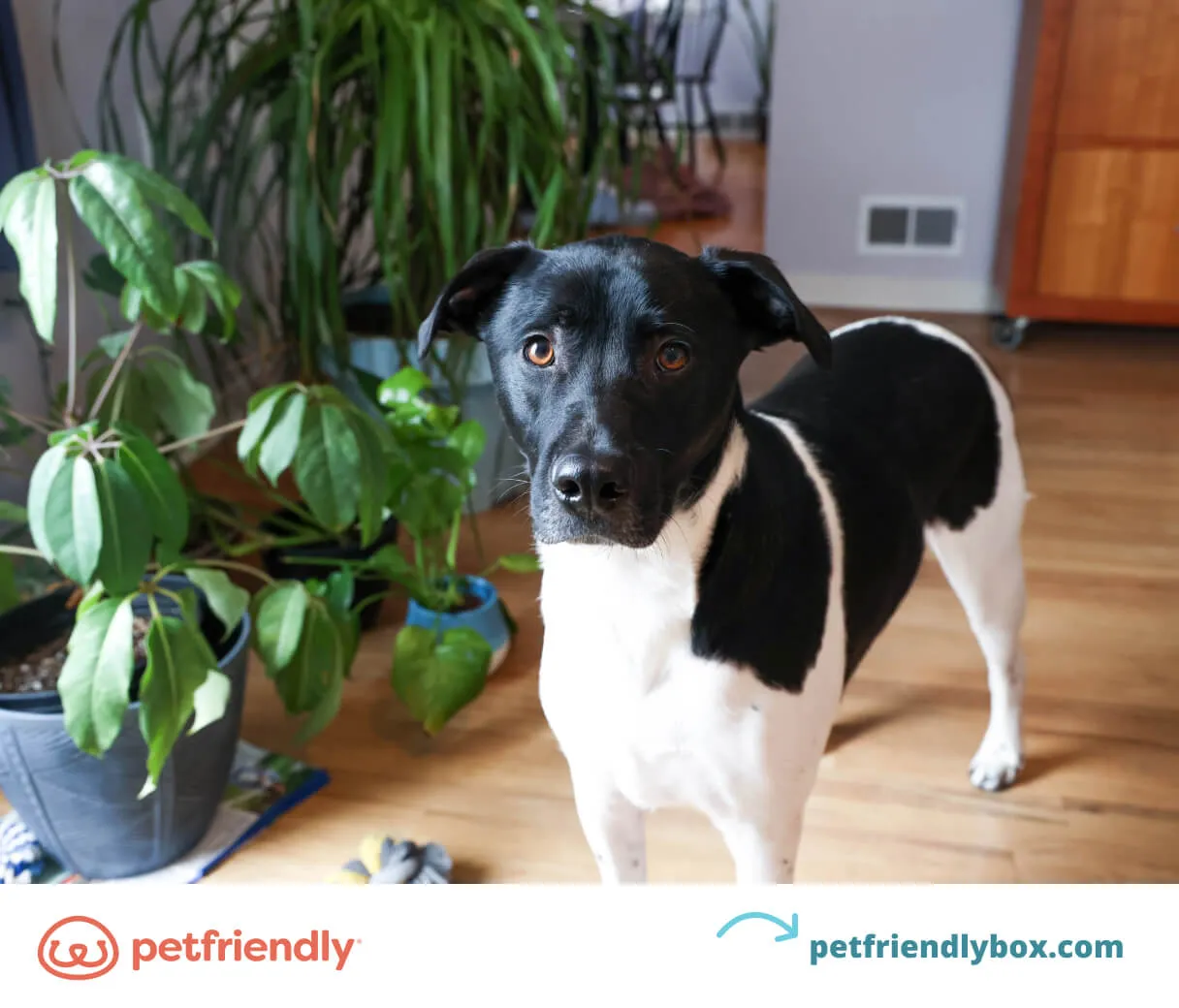 Dog taking steps backward on command, learning body awareness with the 'back up' trick
Dog taking steps backward on command, learning body awareness with the 'back up' trick
How to teach your dog to back up
Start with an open space. Before commencing back up training, ensure you are in an area with ample room for movement, like a long hallway or an open outdoor space. This provides sufficient room for your dog to learn without obstacles.
Step, step, reward. With your dog standing directly in front of you, take a deliberate step towards them. The moment your pet takes a step backward with their hind legs, immediately reward them with a treat.
Add the command. After several repetitions where your dog consistently backs up, begin to incorporate the verbal command “back” or “back up” as they perform the action. With consistent practice of this dog trick, your dog should soon automatically walk backward upon hearing the verbal command alone.
8. Shake paws
Teaching your dog to shake paws is a classic touch trick that is remarkably easy for most dogs to learn. Simple yet charming tricks like shake are wonderful for entertaining friends and family, adding a polite and interactive element to your dog’s repertoire.
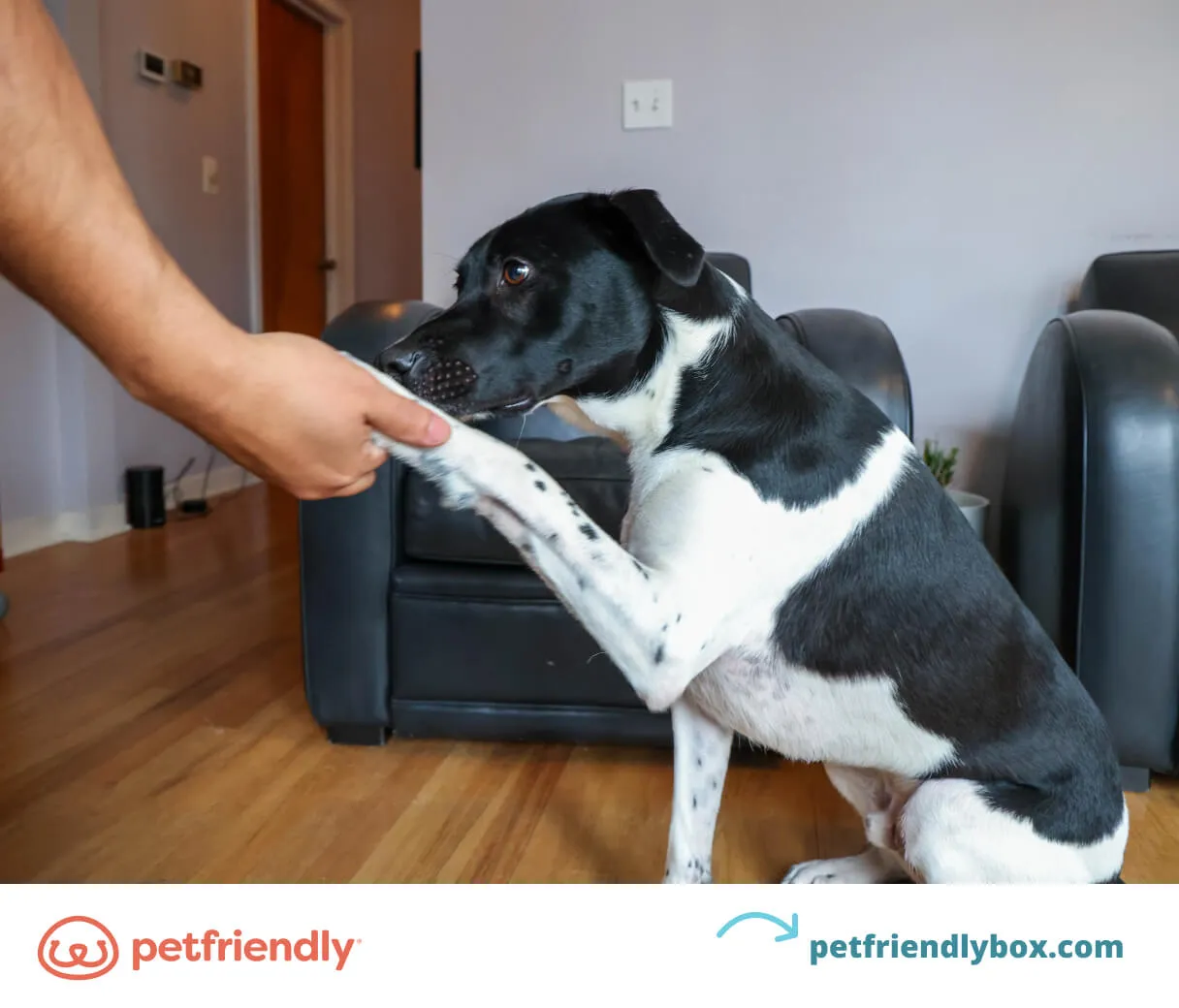 Friendly dog offering its paw for a 'shake hands' trick, a fun social command
Friendly dog offering its paw for a 'shake hands' trick, a fun social command
How to teach your dog to shake hands (paws)
Start with “sit.” To begin teaching your dog to shake hands, instruct them to start in a sitting position. Hold a small, high-value treat in your closed hand, just out of their reach, directly in front of your dog.
Add the command. As your dog attempts to get the treat, repeat the phrase “shake” while gently tapping one of your dog’s front feet with your other hand. Most dogs will instinctively raise their paw to try and dislodge the treat from your hand.
Catch and repeat. The moment your dog raises their paw, gently catch it with your open hand. Say your command word “shake” clearly and immediately reward them with the treat. This immediate pairing helps your dog associate the command with the desired action. Repeat these steps consistently until your dog automatically lifts their paw upon hearing the shake command.
9. Play dead (or rollover)
While play dead isn’t an essential dog training trick like sit, shake hands, or stay, it is a highly entertaining new trick that can add flair to your pet’s skill set. As long as your pet has a firm grasp of the down command, they should be able to pick up this trick in just a few straightforward steps. It’s one of the more impressive easiest tricks to teach your dog once the fundamentals are in place.
 Dog dramatically 'playing dead' on its side, an entertaining advanced trick
Dog dramatically 'playing dead' on its side, an entertaining advanced trick
How to teach your dog to play dead
Start with your dog in a lying position. Use the down command to get your dog into a comfortable lying down position.
Lure with a high-value treat. Hold a treat close to your dog’s nose. Slowly move it in a sweeping sideways motion, encouraging your dog to roll over onto their side as they follow the treat.
Reward. When your dog is comfortably lying on their side, immediately reward them with the treat. Repeat this step several times to help your dog become accustomed to lying on their side in this manner.
Add the command. Once your dog consistently rolls onto their side, begin to introduce a verbal command or a distinctive hand signal. The verbal command could be “play dead,” “bang,” or any word you choose.
Bonus! Incorporate a hand signal. Many dog owners enhance this trick by adding a hand signal, such as holding up fingers in a gun shape and pointing it at their dog. After your dog reliably associates the command with the rolling behavior, reward them with a treat.
10. Speak
Barking is a natural and primary way for dogs to express themselves and communicate. However, there are times when pet parents need their dogs to be quiet. While barking is a normal behavior, and dogs bark when they are seeking attention, communicating with other animals, or displaying territorial instincts, excessive barking can be a nuisance.
Teaching your pet when it’s acceptable to speak on command, and consequently, when to be quiet, can significantly help with impulse control and manage problem barking. This trick empowers you to control their vocalizations rather than suppress them completely.
 Energetic dog barking on cue for the 'speak' command, managing vocalization
Energetic dog barking on cue for the 'speak' command, managing vocalization
How to teach your dog to speak
Lure with an enticing reward. With your dog positioned in front of you, make it clear that you possess something they strongly desire. This could be their favorite tennis ball, another beloved toy, or a particularly high-value treat.
Wait for a response. If your pet is familiar with other dog tricks, they might start performing a few of them in an attempt to earn the reward. Out of excitement or frustration, your dog might then make a noise or bark.
Mark the bark. The instant your pet makes a vocalization or barks, immediately mark that behavior with the command “speak” and then reward them. Repeat this process consistently until your dog understands how to speak reliably on command.
11. Take a bow
The bow command, or take a bow, comes quite naturally to some pets, particularly those who stretch frequently. Instead of simply saying “ooooh, big stretch” when your pet assumes this elegant position, leverage that natural behavior by using the command “bow” or “take a bow” to reinforce this delightful dog trick. It’s a charming way to formalize a natural posture into a controlled command.
 Dog performing a graceful 'take a bow' trick, lowering its front body playfully
Dog performing a graceful 'take a bow' trick, lowering its front body playfully
How to teach your dog to take a bow
Lure with a high-value treat. With your dog standing upright in front of you, hold a treat directly in front of their nose. Slowly move the treat downwards towards the floor. Your dog’s nose should follow the treat’s path all the way to the ground.
Add the command. As you lower the treat, clearly say the command “bow” or “take a bow.” When your dog’s front legs are lowered to the ground while they remain standing on their hind legs (in a bowing posture), immediately reward them with the treat. Repeat this process until your pet consistently performs this unique dog trick on command.
12. Spin
The spin trick is a dynamic and fun addition to your collection of dog tricks. While not an essential obedience command, spin is an enjoyable and easiest trick to teach your dog, especially for a new canine companion. It’s a great way to engage their bodies and minds in a playful manner.
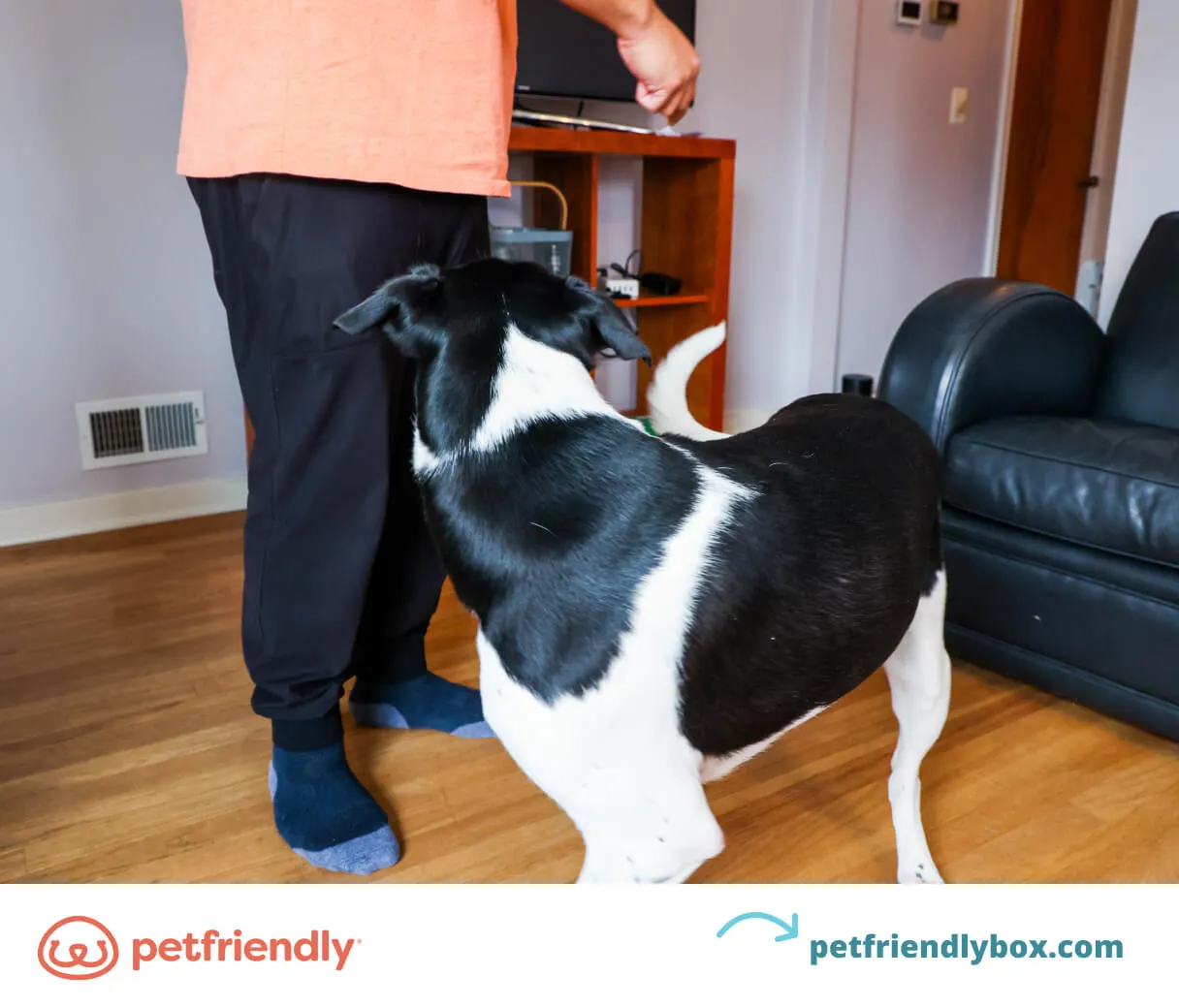 Happy dog spinning in a circle on command, a dynamic and fun trick
Happy dog spinning in a circle on command, a dynamic and fun trick
How to teach your dog to spin
Lure with a high-value treat. To guide your dog into a spin, hold a dog treat close to your dog’s nose. Slowly move it towards one side of their head, encouraging your dog to turn their head to follow the treat.
Add the command. While continuously moving the treat around the side of your pet’s head, clearly say the command “spin.” Continue guiding the treat in a complete circle until your dog has spun all the way around.
Reward and repeat. Once your dog completes the full circle and you are back in your starting position, immediately reward your dog with a treat. Repeat these steps consistently until your dog reliably makes a complete circle with only the verbal command “spin.”
Final tips for teaching your dog tricks
Now that you’ve learned some of the easiest tricks to teach your dog for beginners, it’s crucial to remember a few essential tips that will significantly help you along your training journey:
- Keep training sessions short. Dogs have limited attention spans. Brief, focused sessions prevent boredom and frustration.
- Start with basic commands before moving on to more fun tricks. A strong foundation in commands like
sitandstaymakes learning advanced tricks much easier. - Aim for 15 to 20-minute training sessions, once or twice a day. This frequency is ideal for consistent learning without overwhelming your dog.
- Utilize pieces of your dog’s regular food or supplements as “treats” during training. This helps manage calorie intake and prevents over-feeding.
- Plan training times around meal times. A slightly hungry dog is often more motivated by food rewards.
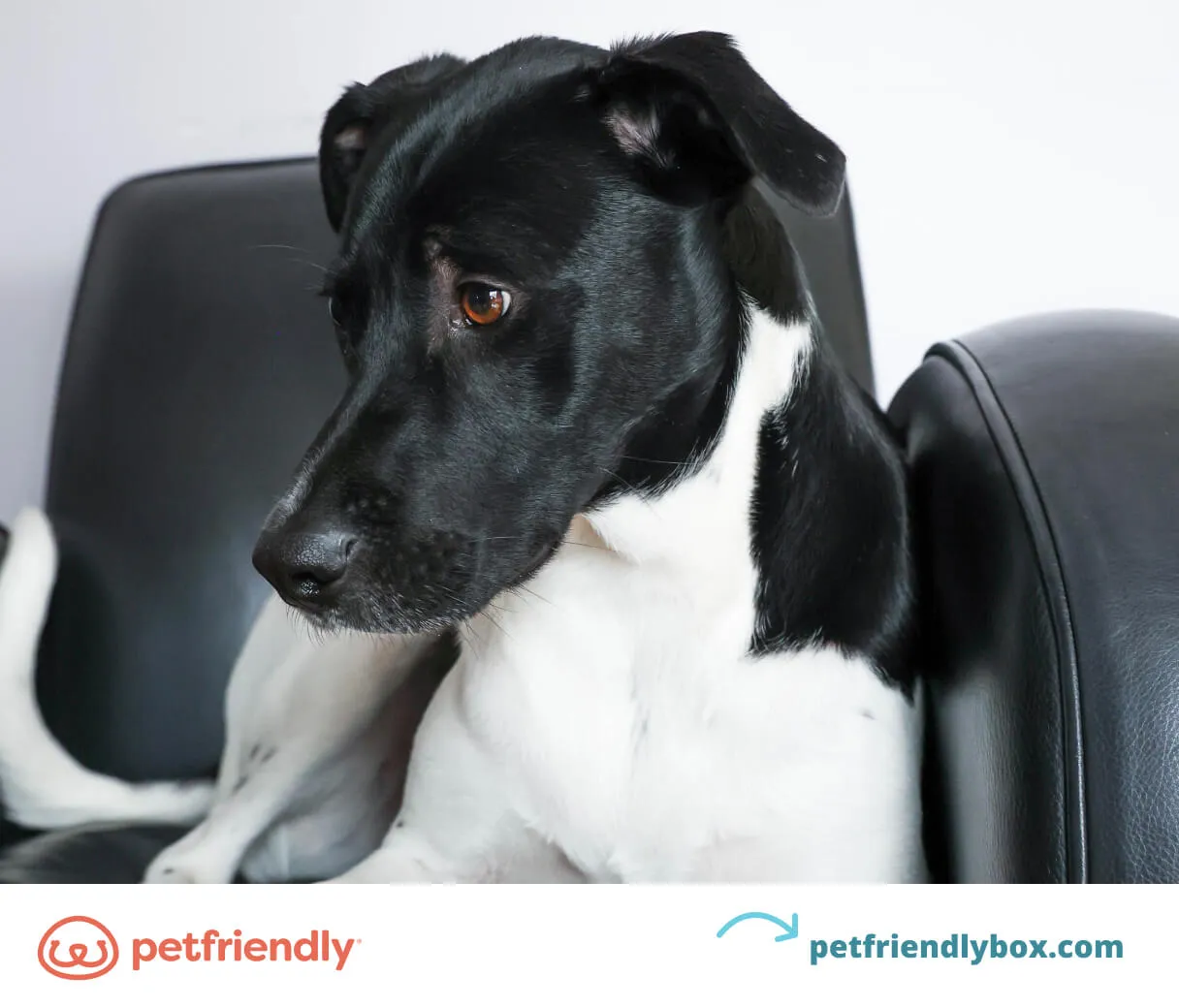 Dog and owner bonding during a training session, highlighting final tips for teaching tricks
Dog and owner bonding during a training session, highlighting final tips for teaching tricks
Behavior and trick training is an excellent way to stimulate your pet’s brain, enhance their cognitive abilities, and most importantly, strengthen the bond you share. Remember, not all dogs are quick learners; some breeds or individuals may take longer to grasp new concepts. The key is to spend consistent time training, remain patient, and always ensure the process is fun and rewarding for both you and your furry friend. Continue to explore new skills, and celebrate every small victory!
